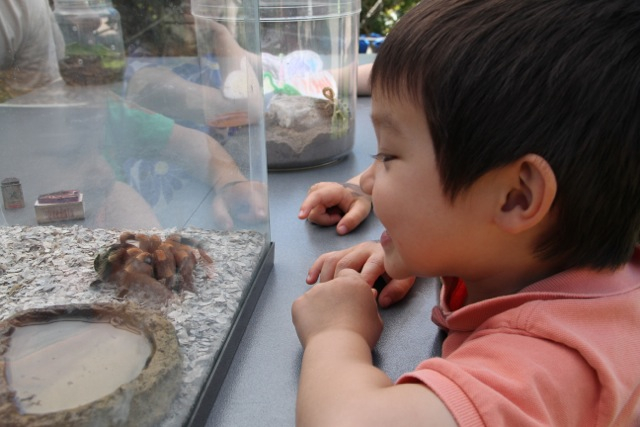

What has more than two thousand legs and is converging on San Francisco’s Corona Heights neighborhood? A: The parents, children, insects and arachnids who collectively take part in Bug Day at the city’s Randall Museum. Q: Who is responsible? A: Nancy Ellis, Science Curator. And she’s thrilled. I spoke recently with Nancy about Bug Day, and how she came to the Randall.
Before I began, Nancy made sure I understood one point:
Ellis: The Randall Museum is part of the San Francisco Department of Recreation and Parks. The reason that’s important is because it makes us free. The Randall Museum Friends is an affiliated nonprofit organization that does fundraising to help us do additional programming like Bug Day, Family Day, and classes.
BN: Duly noted. Did you grow up in the Bay Area? If not, how did you get here?
Ellis: I lived in Ohio until I was 29 and worked for the state parks system at a nature center. . At a certain point, I just wanted to come to California. If you’ve ever lived in Ohio, you’d know why. The truth is, I wanted to be near the water. In college, I had worked as a veterinary technician at a zoo, so in 1988, I got a job as a vet tech for surgery and animal medicine at a veterinary hospital in San Francisco. At the time, I thought I wanted to be a vet. I went back to school at San Francisco State to get the prerequisites. I applied twice to UC Davis, but didn’t get in.
But meanwhile, a lot of things came together at SF State. I discovered marine biology and ecology. It changed how I thought about my career: Instead of vaccinations and surgery on limbs, I now wanted to teach people about all of California’s amazing landscapes and wildlife. They’re so diverse!
So I ended up getting an MA in Science Education in 1998. I got the job at the Randall Museum in 1996, while I was completing the program.
BN: Tell me more about Bug Day.
Ellis: My predecessor started Bug Day ten years before I arrived. People adore it. They call us in advance to find out the date of the next Bug Day. The goals of the day are to make the public understand how important insects are to our world, and to explain how interesting bugs are because they’re so different from us.

At the event, we often have university entomology students and faculty come show what they’re working on. For example, Gretchen LeBuhn at San Francisco State has been studying native bees. She came up with the idea for The Great Sunflower Project. At the event she hands out sunflower seeds to people. They plant them, then report the number of bees that visit their flowers. It’s a great example of “citizen science.”
Some activities are just plain fun. We have an insect Olympics, in which kids try to jump as far and as high as a grasshopper, proportional to their own body. This would be roughly equivalent to them jumping over City Hall. There’s always a lot of bug art, such as making insects out of upcycled scrap material.
One of the highlights of the event is the San Francisco Beekeeper’s Association. They set up a screen house and put a hive of bees inside. In beekeeper garb, they open the hive and show people what’s inside. The San Francisco Zoo and SaveNature.org bring large insects, like the Madagascar hissing cockroach, that kids can hold.
And then we have Monica Martinez, proprietor of Don Bugito, a “Prehispanic Snackeria,” who creates a dish for us each year. This year, she’s making cricket and mealworm ice cream. In addition to serving her eclectic cuisine, Martinez seeks to educate people about the sustainability of bugs as a protein source, and about the various cultural traditions that serve bugs regularly.
BN: What is your favorite outdoor destination in the Bay Area?
Ellis: Can I say three? I do a lot of biking in the East Bay hills, and I especially like Wildcat Canyon Road, Old Tunnel Road, and Tilden Park. And there’s also the San Francisco coastline, from Fort Funston, through Ocean Beach, and on to the Cliff House. And then I love Aquatic Park in Berkeley. There’s an amazing amount of bird life there, some truly astonishing aquatic waterfowl.
Randall Museum’s Bug Day will be held on Saturday, April 27th from 10 AM – 2 PM. Get program info and more details here.




